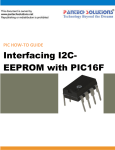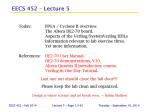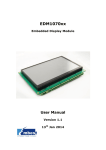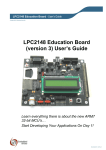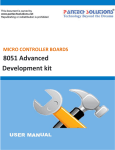Download 2 - Pantech Solutions
Transcript
PSPRIMER-FPGASP3 SPARTAN3 Development Kit Hardware & Software User Manual 1 www.pantechsolutions.net L-scheme VLSI Lab Manual Contents 1. Introduction ................................................................................................................................................ 3 1.1 – Packages ................................................................................................................................................... 3 1.2 - Technical or Customer Support ............................................................................................................... 3 2. Key Components and Features .................................................................................................................. 4 2.1- General Block Diagram................................................................................................................................. 5 3. Jumper & Switch Details............................................................................................................................. 6 4. Connector Details ....................................................................................................................................... 7 5. Power Supply............................................................................................................................................... 8 6. On-board Peripherals ................................................................................................................................. 9 6.1 - Light Emitting Diodes ................................................................................................................................ 10 6.2 – Digital Inputs ............................................................................................................................................. 11 6.3 – 2x16 Char LCD Display .............................................................................................................................. 12 6.4 – 7-Segment Display .................................................................................................................................... 13 6.5 - 4x4 Matrix keypad and Push Button ........................................................................................................ 14 6.6 – Stepper Motor .......................................................................................................................................... 15 6.7 - DC Motor.................................................................................................................................................... 16 6.8 – Relay Interface .......................................................................................................................................... 17 6.9 – Buzzer Interface ........................................................................................................................................ 17 6.10 – Traffic Light Controller ........................................................................................................................... 18 7 - Peripherals Section - II.................................................................................................................................. 19 7.1 - RS-232 Communication (USART) .............................................................................................................. 19 7.2 – Clock Source .............................................................................................................................................. 19 7.3 – JTAG Programmer..................................................................................................................................... 20 7.4 - VGA Interface............................................................................................................................................. 21 7.5 - PS/2 Interface ............................................................................................................................................ 24 7.6 - 128x64 GLCD Graphical LCD ..................................................................................................................... 27 7.7 – Serial EEPROM .......................................................................................................................................... 29 7.8 - Real Time Clock (DS1307) ......................................................................................................................... 30 8. VLSI Lab Experiments..................................................................................................................................... 32 9 - Getting Started with Xilinx ISE ..................................................................................................................... 92 2 www.pantechsolutions.net L-scheme VLSI Lab Manual 1. Introduction Thank you for purchasing the Xilinx Spartan-3 Development Kit. You will find it useful in developing your Spartan-3 FPGA application. FPGASP3 Kit (DPK) is an exclusive general-purpose kit for the SPARTAN family. The intention of the design is to endorse the engineers and scholars to exercise and explore the capabilities of FPGA architectures with many interfacing modules on board point LEDs, Slide switches, Traffic light, LCD, 7-Seg, UART, VGA, and PS/2 with ease to create a standalone versatile test platform. 1.1 – Packages Spartan3 Development Kit (XC3S200) Serial Port Cable JTAG Programming Cable Printed User Manual CD contains o Software (Programmers, ISE) o Example Programs o User Manual 1.2 - Technical or Customer Support E-mail questions to : [email protected] Send questions by mail to Pantech Solutions Pvt Ltd., 151/34, Mambalam High Road, Sri Ranga Building, T. Nagar, Chennai - 600 017 Tamilnadu, India Phone : +91-44-4260 6470 Fax : +91-44-4260 6350 Website : www.pantechsolutions.net 3 www.pantechsolutions.net L-scheme VLSI Lab Manual 2. Key Components and Features On-Chip Features 200,000-gate Xilinx Spartan 3 FPGA in a 144-TQFP (XC3S200-4TQG144C) 4,320 logic cell equivalents Twelve 18K-bit block RAMs (216K bits) Twelve 18x18 hardware multipliers Four Digital Clock Managers (DCMs) Up to 97 user-defined I/O signals On-Board Features 10 Nos. Slide Switches for digital inputs 10 nos. of Point LEDs for Digital outputs 2 Nos. of Push Button 2x16 Character LCD interface 4 Nos. 7-segment LED CA display 2 Nos. of 5V SPDT Relay with termination. 4x4 Matrix Keypad interface 4-Way Traffic Light controller Module Stepper motor Driver interface DC Motor interface controlled by PWM 3-bit, 8-color VGA display port. RS-232 Serial Port. PS/2-connector( for mouse/keyboard interface) port 128x64 GLCD Module Interface (Optional) Serial EEPROM (Optional) I2C Real Time Clock with battery back-up (Optional) 1-Wire Digital Temperature Sensor (Optional) 50 MHz crystal oscillator clock source 20-pin I/o connector for interface external peripherals modules JTAG port for download user program through cable 9V AC/DC power input through adapter On-board 5V, 3.3V, 2.5V, and 1.2V regulators. 4 www.pantechsolutions.net L-scheme VLSI Lab Manual 2.1- General Block Diagram 9V Input +5V/3.3V/1.2V JTAG Port 2 Nos. of Push Button UART Serial Comm 2 Nos SPDT Relay 3-bit 8-color VGA Interface PS/2 10 Nos. LED Digital Outputs 20-pin I/O connector 10 Slide Switch Digital Outputs Traffic Light Module 4 Nos of 7segment DISP XC3S200 5 2x16 Char LCD DC Motor Interface Stepper Motor Driver Buzzer GLCD128x64 I2C RTC I2C EEPROM 1-Wire Temp www.pantechsolutions.net L-scheme VLSI Lab Manual 3. Jumper & Switch Details Stepper / Relay 1 2 3 Internal Supply (+5V) 1 2 3 External Supply(+5V) 1 2 3 Internal Supply (+5V) 1 2 3 External Supply(+5V) 1 2 3 Enable Buzzer 1 2 3 Disable Buzzer JP5 DC Motor JP6 Buzzer (P5) JP7 Switch Details Program Execution Mode Selection ( EXE MODE) Execution through JTAG JTAG/PROM J6 Execution through PROM GLCD / Traffic Light Selection Select GLCD GLCD/Traffic SW28 Select TRAFFIC +5V Power Selection SW1 +5V 1 2 3 4 8 7 6 5 P7SEG PLCD PSM/RL PGLCD SW DIP-4 6 www.pantechsolutions.net L-scheme VLSI Lab Manual 4. Connector Details 20pin – Box Connector J7 1 3 5 7 9 11 13 15 17 19 IO63 IO69 IO73 IO76 IO78 IO80 IO83 IO102 2 4 6 8 10 12 14 16 18 20 IO68 IO70 IO74 IO77 IO79 IO82 IO84 IO103 CONN TRBLK 8x2 +5V JTAG Connector J2 1 2 3 4 5 6 TMS TDI TDO TCK GND VCC CON6 7 www.pantechsolutions.net L-scheme VLSI Lab Manual 5. Power Supply The external power can be AC or DC, with a voltage between (9V, 1A output) at 230V AC input. The SPARTAN3 board produces +5V using an LM7805 voltage regulator, which provides supply to the peripherals. USB socket meant for power supply and USB communication, user can select either USB or Ext power supply through SW1. Separate On/Off Switch (SW1) for controlling power to the board. ON/OFF Power +5V ON -External through Adaptor SW2 Power +5V ON - Internal through USB There are multiple voltages supplied on the Spartan-3 Evaluation Kit, 3.3V, 2.5V and 1.2V regulators. Similarly, the 3.3V regulator feeds all the VCCO voltage supply inputs to the FPGA’s I/O banks and powers most of the components on the board. The 2.5V regulator supplies power to the FPGA’s VCCAUX supply inputs. The VCCAUX voltage input supplies power to Digital Clock Managers (DCMs) within the FPGA and supplies some of the I/O structures. In specific, all of the FPGA’s dedicated configuration pins, such as DONE, PROG_B, CCLK, and the FPGA’s JTAG pins, are powered by VCCAUX. The FPGA configuration interface on the board is powered by 3.3V. Consequently, the 2.5V supply has a current shunt resistor to prevent reverse current. Finally, a 1.2V regulator supplies power to the FPGA’s VCCINT voltage inputs, which power the FPGA’s core logic. The board uses four discrete regulators to generate the necessary voltages. 8 www.pantechsolutions.net L-scheme VLSI Lab Manual 6. On-board Peripherals The Development Kit comes with many interfacing options 8 Nos. Slide Switches for digital inputs 8 nos. of Point LEDs for Digital outputs 2x16 Character LCD interface 4 Nos. 7-segment LED CA display 2 Nos. of 5V SPDT Relay with termination. 4x4 Matrix Keypad interface 4-Way Traffic Light controller Module Stepper motor Driver interface DC Motor interface controlled by PWM Buzzer Interface UART for serial port communication through PC GLCD | I2C EEPROM | RTC | 1-Wire Temp Sensor (Optional) JTAG Programmer Clock Source 3-bit, 8 Color VGA Interface PS/2 Keyboard interface 9 www.pantechsolutions.net L-scheme VLSI Lab Manual 6.1 - Light Emitting Diodes Light Emitting Diodes (LEDs) are the most commonly used components, usually for displaying pin’s digital states. The FPGASP3 KIT has 8 nos., of Point LEDs, connected with port pins (details tabulated below); the cathode of each LED connects to ground via a 330Ω resistor. To light an DIGITAL OUTPUTS individual LED, drive the associated FPGA control signal to High. 10 Point LEDs XC3S200 - Pins LED-D9 P14 LED-D10 P15 LED-D11 P17 LED-D12 P18 LED-D13 P20 LED-D14 P21 LED-D15 P23 LED-D16 P24 LED-D29 P50 LED-D30 P53 LED Selection LED1 R1 330E Make Pin High – LED ON Make Pin Low – LED OFF www.pantechsolutions.net L-scheme VLSI Lab Manual 6.2 – Digital Inputs This is another simple interface, of 8-Nos. of slide switch, mainly used to give an input to the port lines, and for some control applications also. The FPGASP3 KIT, slide switches (SW20-SW27) directly connected with FPGA I/O lines (details tabulated below), user can give logical inputs high through slide switches. The switches are connected to +3.3V, in order to detect a switch state, by default lines are pulldowned through resistors. The switches typically exhibit about 2 ms of mechanical bounce and there is no active de-bouncing circuitry, although such circuitry could easily be added to the FPGA DIGITAL INTPUTS design programmed on the board. A 10KΩ series resistor provides nominal input protection. 11 Slide Switch XC3S200 - Pins SW20 P25 SW21 P26 SW22 P27 SW23 P28 Slide Switch Logic VCC R 10k 2 R 10k 1 SW1 SW24 P30 SW25 P31 SW26 P32 Make Switch Close – High SW27 P33 Make Switch Open – Low SW29 P93 SW30 P103 www.pantechsolutions.net L-scheme VLSI Lab Manual 6.3 – 2x16 Char LCD Display The 2x16 character LCD interface card with supports both modes 4-bit and 8-bit interface, and also facility to adjust contrast through trim pot. In 8-bit interface 11 lines needed to create 8-bit interface; 8 data bits (D0 – D7), three control lines, address bit (RS), read/write bit (R/W) and control signal (E). The LCD controller is a standard KS0070B or equivalent, which is a very well- DATA LINES P105 E P107 D0 P108 D1 P112 D2 P113 D3 P116 D4 P118 D5 P119 D6 P122 D7 P123 LED- RW D6 D7 LED+ P104 D3 D4 D5 RS 2x16 LCD Selection D0 D1 D2 XC3S200-Pins RS R/W E LCD MODULE GND VCC VEE CONTROL known interface for smaller character based LCDs. +5V SW1 Make switch SW1 to ‘LCD’ label marking position OFF 1 2 3 4 8 ON 7 6 5 7SEG LCD SM/RL GLCD PWR ON/OFF 12 www.pantechsolutions.net L-scheme VLSI Lab Manual 6.4 – 7-Segment Display The Spartan-3 FPGASP3 Kit has a four-character, seven segments LED display controlled by FPGA user-I/O pins. Each digit shares eight common control signals to light individual LED segments. Each individual character has a separate anode control input. The pin number for each FPGA pin connected to the LED display is shown in below table. To light an individual signal, drive the individual segment control signal Low along with the associated anode control signal for the Segment Lines Digit - 1 P124 Digit – 2 P125 Digit – 3 P127 Digit - 4 P128 Seg - a P129 Seg – b P130 Seg – c P131 Seg – d P132 Seg – e P135 Seg – f P137 Seg – g P140 Seg – dp P141 7-Segment Display VCC 1 XC3S200-Pins 1K Digit - 1 2 seg-a Seg-b Seg-c seg-d seg-e seg-f seg-g seg--dp 7 6 4 2 1 9 10 5 A B C D E F G DP 8 U1 CA 3 3 7-Segment CA Digit Select individual character. a 7 SEG DISP f g b Make high to - digit selection e d c Make low to - segment +5V SW1 Make switch SW1 to ‘7SEG’ label marking position OFF 1 2 3 4 8 ON 7 6 5 7SEG LCD SM/RL GLCD PWR ON/OFF 13 www.pantechsolutions.net L-scheme VLSI Lab Manual 6.5 - 4x4 Matrix keypad and Push Button Keypads arranged by matrix format, each row and column section pulled by high, all row lines ROW and column lines connected directly by the i/o pins. ROW-2 P86 ROW-3 P87 ROW-4 P89 COLUMN-1 P90 C4 P85 C3 ROW-1 Matrix Format C2 XC3S200-pins C1 4x4 Matrix Keys SW1 SW2 SW3 SW4 SW5 SW6 SW7 SW8 SW9 SW10 SW11 SW12 SW13 SW14 SW15 SW16 R1 R2 COLUMN R3 COLUMN-2 P92 COLUMN-3 P95 COLUMN-4 P96 R4 The Spartan3 FPGA Kit has four contact push button switches for interrupt input. PUSH BUTTON 14 XC3S200-pins SW31 P103 SW32 P102 www.pantechsolutions.net L-scheme VLSI Lab Manual 6.6 – Stepper Motor The ULN2803A is a high-voltage, high-current Darlington transistor array. The device consists of eight NPN Darlington pairs that feature high-voltage outputs with common-cathode clamp diodes for switching inductive loads. The collector-current rating of each Darlington pair, 500 mA. ULN2803 is used as a driver for port I/O lines, drivers output connected to stepper motor, P82 COIL-B P83 COIL-C P99 COIL-D P100 VCC MOTOR_PWR STEPPER COIL-A COIL-B COIL-C COIL-D IN1 IN2 IN3 IN4 1 2 3 OUT1 OUT2 OUT3 OUT4 MG1 EN1 EN2 6 COIL-A Stepper Motor PWR Select 5 XC3S200-Lines 4 Stepper Motor(5V) VS VSS STEPPER MOTOR connector provided for external power supply if needed. JP5 1 2- Internal +5V (Stepper Motor) 3 +5V SW1 Make switch SW1 to SM/RL label marking position. OFF 1 2 3 4 8 7 6 5 ON 7SEG LCD SM/RL GLCD PWR ON/OFF For Motor/relay designer get power from on-board (internal) or external supply through jumper JP5, by default JP5 pin 1&2 shorted 15 www.pantechsolutions.net L-scheme VLSI Lab Manual 6.7 - DC Motor 5V DC Motor speed has controlled through PWM signal. Motor can run both clockwise/counter clockwise, Motor speed controlled by varying ENA (duty cycle) signal through program. DC Motor(5V) XC3S200-Lines COIL-A P82 DC Motor PWR Select COIL-B P83 ENA P99 - 1 OUT1 OUT2 A IN1 IN2 + PWM1 PWM2 MOTOR SERVO VS VSS DC MOTOR VCC 2 MG2 ENA EN1 JP6 1 2- Internal +5V (Stepper Motor) 3 +5V SW1 Make switch SW1 to SM/RL label marking position. OFF 1 2 3 4 8 7 6 5 ON 7SEG LCD SM/RL GLCD PWR ON/OFF For DC Motor designer get power from on-board (internal) or external supply through jumper JP6, by default JP6 pin 1&2 shorted. 16 www.pantechsolutions.net L-scheme VLSI Lab Manual 6.8 – Relay Interface ULN2803 is used as a driver for port I/O lines, drivers output connected to relay modules. Connector provided for external power supply if needed. Relay Module : Spartan3 FPGA pins (Realy1 – P59) and (Relay2-P60) for relay module, make port pins to high, relay will activated RELAY SPDT RELAY Power Select XC3S200-pins RELAY Modules +5V SW1 Relay-1 P59 OFF 1 2 3 4 8 ON 7 6 5 7SEG LCD SM/RL GLCD PWR ON/OFF Relay-2 P60 JP5 1 Note 2- 3 Internal +5V (Stepper Motor) : Relay selection make switch SW1 to SM/RL label marking position For Motor/relay designer get power from on-board (internal) or external supply through jumper JP5, by default JP5 pin 1&2 shorted. 6.9 – Buzzer Interface 5V continuous buzzer connected through FPGA’s I/O pins (P5), to enable buzzer place jumper JP7 at E label mark position. Buzzer Buzzer Module : Spartan3 FPGA pins (Buzzer – P5), make port pins to high, buzzer will activated 17 5V Buzzer XC3S200-pins Buzzer P5 RELAY Power Select JP7 1 2 www.pantechsolutions.net 3 - To Enable Buzzer L-scheme VLSI Lab Manual 6.10 – Traffic Light Controller Traffic light controller card consist of 12 Nos. point led arranged by 4Lanes. Each lane has Go (Green), Listen(Yellow) and Stop(Red) LED is being placed. Each LED has provided for current limiting resistor to limit the current flows to the LEDs. LAN Direction XC3S200-pins NORTH P40 D19-Go P36 D18-Listen P35 D17-Stop P46 D22-Go P44 D21-Listen P41 D20-Stop P51 D25-Go P50 D24-Listen P47 D23-Stop P56 D28-Go P53 D27-Listen P52 D26-Stop WEST SOUTH EAST Note 18 LED’s Traffic Light Controller 330E GO LISTEN STOP LANE NORTH 330E 330E Make high to - LED On Make low to – LED Off LANE EAST LANE WEST SW28 GLCD LANE SOUTH Traffic : Make SW28 to “Traffic” label marking position www.pantechsolutions.net L-scheme VLSI Lab Manual 7 - Peripherals Section - II 7.1 - RS-232 Communication (USART) USART stands for Universal Synchronous Asynchronous Receiver Transmitter. FPGASP3 Kit provides an RS232 port that can be driven by the Spartan-3 FPGA. A subset of the RS232 signals is used on the Spartan 3 kit to implement this interface (RxD and TxD signals). RS-232 communication enables point-to-point data transfer. It is commonly used in data acquisition applications, for the transfer of data between the microcontroller/FPGA and a PC. The voltage levels of a FPGA and PC are not directly compatible with those of RS-232, a level transition buffer such as MAX3232 be used. SPARTAN3 FPGA Lines TXD P15 Serial Port Section UART UART DB-9 Connector SPARTAN3 RXD MAX 3232 P14 7.2 – Clock Source The FPGASP3 Kit has a dedicated 50 MHz series clock oscillator source and an optional socket for Oscillator another clock oscillator source. 19 U18 Signal SPARTAN3 FPGA Lines 50MHz Clock P55 www.pantechsolutions.net Crystal Oscillator L-scheme VLSI Lab Manual 7.3 – JTAG Programmer The FPGASP3 Kit includes a JTAG programming and debugging chain. Pantech JTAG3 low-cost parallel to JTAG cable is included as part of the kit and connects to the JTAG header. DB-25 parallel port connector to 6 pin female header connector. The JTAG cable connect directly to the parallel port of a PC and to a standard 6 pin JTAG programming header in the kit, can program a devices that have a JTAG voltage of 1.8V or greater. 6-Pin JTAG Programmer Header JTAG Signals SPARTAN3 FPGA Lines 1 TMS P111 2 TDI P144 3 TDO P109 4 TCK P110 5 GND 6 VCC JTAG Cable – III The Pantech low-cost parallel port to JTAG cable fits directly over the header stake pins, as shown in above figure. When properly fitted, the cable is perpendicular to the board. Make sure that the signals at the end of the JTAG cable align with the labels listed on the board. The other end of the Pantech cable connects to the PC’s parallel port. The Pantech cable is directly compatible with the Xilinx iMPACT software. 20 www.pantechsolutions.net L-scheme VLSI Lab Manual 7.4 - VGA Interface The FPGASP3 Kit includes a VGA display port through DB15 connector, Connect this port directly to most PC monitors or flat-panel LCD displays using a standard monitor cable As shown in table, the Spartan-3 FPGA controls five VGA signals: RED (R) its 1ST pin in connector, GREEN (G) its 2nd pin, BLUE (B) its 3rd pin, Horizontal Sync (HS) 13th pin, and Vertical Sync (VS) its 14th pin, all available on the VGA connector. DB-15 Connector VGA Signals SPARTAN3 FPGA Lines Vertical Sync(VS) P6 Horizontal Sync(HS) P7 Blue P8 Green P10 Red P11 Each color line has a series resistor to provide 3-bit color, with one bit each for Red, Green, and Blue. The series resistor uses the 75 ohm VGA cable termination to ensure that the color signals remain in the VGA-specified 0V to 0.7V range. The HS and VS signals are TTL level. Drive the R, G, and B signals High or Low to generate the eight possible colors shown in below table. RED GREEN BLUE RESULTING COLOUR 0 0 0 BLACK 0 0 1 BLUE 0 1 0 GREEN 0 1 1 CYAN 1 0 0 RED 1 0 1 MAGNETA 1 1 0 YELLOW 1 1 1 WHITE VGA signal timing is specified, published, copyrighted, and sold by the Video Electronics Standards Association (VESA). The following VGA system and timing information is provided as 21 www.pantechsolutions.net L-scheme VLSI Lab Manual an example of how the FPGA might drive VGA monitor in 640 by 480 modes. For more precise information or for information on higher VGA frequencies, refer to documents available on the VESA website or other electronics Websites: Video Electronics Standards Association http://www.vesa.org VGA Timing Information http://www.epanorama.net/documents/pc/vga_timing.html Signal Timing for a 60Hz, 640x480 VGA Display CRT-based VGA displays use amplitude-modulated, moving electron beams (or cathode rays) to display information on a phosphor-coated screen. LCD displays use an array of switches that can impose a voltage across a small amount of liquid crystal, thereby changing light permittivity through the crystal on a pixel by- pixel basis. Although the following description is limited to CRT displays, LCD displays have evolved to use the same signal timings as CRT displays. Consequently, the following discussion pertains to both CRTs and LCD displays. Within a CRT display, current waveforms pass through the coils to produce magnetic fields that deflect electron beams to transverse the display surface in a “raster” pattern, horizontally from left to right and vertically from top to bottom. As shown in below figure, information is only displayed when the beam is moving in the “forward” direction—left to right and top to bottom—and not during the time the beam returns back to the left or top edge of the display. Much of the potential display time is therefore lost in “blanking” periods when the beam is reset and stabilized to begin a new horizontal or vertical display pass. The size of the beams, the frequency at which the beam traces across the display, and the frequency at which the electron beam is modulated determine the display resolution. Modern VGA displays support multiple display resolutions, and the VGA controller indicates the resolution by producing timing signals to control the raster patterns. The controller produces TTL-level synchronizing pulses that set the frequency at which current flows through the deflection coils, and it ensures that pixel or video data is applied to the electron guns at the 22 www.pantechsolutions.net L-scheme VLSI Lab Manual correct time. Video data typically comes from a video refresh memory with one or more bytes assigned to each pixel location. The Spartan-3 Evaluation Kit uses three bits per pixel, producing one of the eight possible colors shown in above table. The controller indexes into the video data buffer as the beams move across the display. The controller then retrieves and applies video data to the display at precisely the time the electron beam is moving across a given pixel. The VGA controller generates the HS (horizontal sync) and VS (vertical sync) timings signals and coordinates the delivery of video data on each pixel clock. The pixel clock defines the time available to display one pixel of information. The VS signal defines the “refresh” frequency of the display, or the frequency at which all information on the display is redrawn. The minimum refresh frequency is a function of the display’s phosphor and electron beam intensity, with practical refresh frequencies in the 60 Hz to 120 Hz range. The number of horizontal lines displayed at a given refresh frequency defines the horizontal “retrace” frequency. 23 www.pantechsolutions.net L-scheme VLSI Lab Manual 7.5 - PS/2 Interface The FPGASP3 Kit includes a PS/2 port and the standard 6-pin mini-DIN connector, labeled U11 on the board. User can connect PS/2 Devices like keyboard, mouse to the FPGASP3 KIT. PS/2’s DATA (P8) and CLK (P10) lines connected to SPARTAN3 FPGA I/O Lines. 6PIN MINI Connector PS/2 SPARTAN3 FPGA Lines U11 PS/2 DATA P1 CLK P2 PS/2 PORT SELECT SPARTAN3 Both a PC mouse and keyboard use the two-wire PS/2 serial bus to communicate with a host device, the Spartan-3 FPGA in this case. The PS/2 bus includes both clock and data. Both a mouse and keyboard drive the bus with identical signal timings and both use 11-bit words that include a start, stop and odd parity bit. However, the data packets are organized differently for a mouse and keyboard. Furthermore, the keyboard interface allows bidirectional data transfers so the host device can illuminate state LEDs on the Keyboard. The PS/2 bus timing appears as shown in above figure. The clock and data signals are only driven when data transfers occur; otherwise they are held in the idle state at logic High. The timing defines signal requirements for mouse-to-host communications and bidirectional keyboard communications. The attached keyboard or mouse writes a bit on the data line when the clock signal is High, and the host reads the data line when the clock signal is Low. 24 www.pantechsolutions.net L-scheme VLSI Lab Manual Keyboard The keyboard uses open-collector drivers so that either the keyboard or the host can drive the two-wire bus. If the host never sends data to the keyboard, then the host can use simple input pins. A ps/2-style keyboard uses scan codes to communicate key press data nearly all keyboards in use today are ps/2 style. Each key has a single, unique scan code that is sent whenever the corresponding key is pressed. The scan codes for most keys appear in below figure. If the key is pressed and held, the keyboard repeatedly sends the scan code every 100 ms or so. When a key is released, the keyboard sends an “f0” key-up code, followed by the scan code of the released key. the keyboard sends the same scan code, regardless if a key has different shift and non-shift characters and regardless whether the shift key is pressed or not. The host determines which character is intended. Some keys, called extended keys, send an “e0” ahead of the scan code and furthermore, they might send more than one scan code. When an extended key is released, an “e0 f0” key-up code is sent, followed by the scan code. The host can also send commands and data to the keyboard. Below figure provides a short list of some often-used 25 www.pantechsolutions.net L-scheme VLSI Lab Manual Commands Command Description ED Turn on/off Num Lock, Caps Lock, and Scroll Lock LEDs EE Echo. Upon receiving an echo command, the keyboard replies with the same scan code “EE”. F3 Set scan code repeat rate. The keyboard acknowledges receipt of an “F3” by returning an “FA”, after which the host sends a second byte to set the repeat rate. FE Resend. Upon receiving a resend command, the keyboard resends the last scan code sent FF Reset. Resets the keyboard The keyboard sends commands or data to the host only when both the data and clock lines are High, the Idle state, Because the host is the bus master, the keyboard checks whether the host is sending data before driving the bus. The clock line can be used as a clear to send signal. If the host pulls the clock line Low, the keyboard must not send any data until the clock is released. The keyboard sends data to the host in 11-bit words that contain a ‘0’ start bit, followed by eight bits of scan code (LSB first), followed by an odd parity bit and terminated with a ‘1’ stop bit. 26 www.pantechsolutions.net L-scheme VLSI Lab Manual 7.6 - 128x64 GLCD Graphical LCD The FPGASP3 KIT is the GLCD. 14 pins are needed to create 8-bit interface; 8 data bits (DB0-DB7), two chip select line (CS1) and (CS2), address bit (R/S), read/write bit (R/W) and control signal (E) and Reset (RST). The GLCD controller is a standard S6B0108 or equivalent, which is a very wellknown interface for Graphical based LCDs. LPC2148 Education Board - User’s Guide Page 25 Figure below illustrate the GLCD part of the design and which pins are used for the interface. The LCD – DATA LINES CONTROL L LINES GLCD is powered from the 5V power supply enabled by switch SW1. GLCD XC3S200 LINES CS1 P35 CS2 P36 RS P40 R/W P41 E P44 DB0 P46 DB1 P47 DB2 P50 DB3 P51 DB4 P52 DB5 P53 DB6 P56 DB7 P57 RST High 128x64 GLCD Selection SW28 +5V SW28 Make switch SW1 and SW28 to ‘GLCD’ label marking position 27 GLCD Traffic www.pantechsolutions.net OFF 1 2 3 4 8 ON 7 6 5 7SEG LCD SM/RL GLCD PWR ON/OFF L-scheme VLSI Lab Manual Pin Details of GLCD 28 www.pantechsolutions.net L-scheme VLSI Lab Manual 7.7 – Serial EEPROM The AT24C01A/02/04/08/16 provides 1024/2048/4096/8192/16384 bits of serial electrically erasable and programmable read-only memory (EEPROM) organized as 128/256/512/1024/2048 words of 8 bits each. The device is optimized for use in many industrial and commercial applications where low-power and low-voltage operation are essential. Features of AT24Cxx: Internally Organized 128 x 8 (1K), 256 x 8 (2K), 512 x 8 (4K) 2-wire Serial Interface Bi-directional Data Transfer Protocol 100 kHz (1.8V, 2.5V, 2.7V) and 400 kHz (5V) Compatibility Write Protect Pin for Hardware Data Protection 8-byte Page (1K, 2K), 16-byte Page (4K, 8K, 16K) Write Modes AT 24xx – Data Retention: 100 Years. 29 I2C EEPROM XC3S200-pins SDA P97 Serial EEPROM SPARTAN3 SCL AT24XX EEPROM P98 www.pantechsolutions.net L-scheme VLSI Lab Manual 7.8 - Real Time Clock (DS1307) The Real Time Clock (RTC) is a set of counters for measuring time when system power is on, and optionally when it is off. It uses little power in Power-down mode. On the LPC2148, the RTC can be clocked by a separate 32.768 KHz oscillator, or by a programmable prescale divider based on the VPB clock. Also, the RTC is powered by its own power supply pin, VBAT, which can be connected to a battery or to the same 3.3 V supply used by the rest of the device. Features Measures the passage of time to maintain a calendar and clock. Ultra Low Power design to support battery powered systems. Provides Seconds, Minutes, Hours, Day of Month, Month, Year, Day of Week, Day of Year. Dedicated 32 kHz oscillator or programmable pre-scalar from VPB clock. Dedicated power supply pin can be connected to a battery or to the main 3.3 V. DS1307 30 I2C RTC XC3S200 SDA P97 Real Time Clock SPARTAN3 SCL RTC DS1307 P98 www.pantechsolutions.net L-scheme VLSI Lab Manual VLSI LAB Examples (L-Scheme) 31 www.pantechsolutions.net L-scheme VLSI Lab Manual Contents 8. VLSI Lab Experiments 1. Simulation of VHDL code for combinational circuit 2. Simulation of VHDL code for arithmetic circuits 3. Simulation of VHDL code for multiplexer 4. Simulation of VHDL code for Demultiplexer 5. VHDL implementation of multiplexer 6. VHDL implementation of Demultiplexer 7. VHDL implementation of 7 segment decoder 8. VHDL implementation of 7 segment decoder by LUT 9. VHDL implementation of encoder 10. Simulation of VHDL code for delay 11. VHDL implementation for blinking a led 12. Simulate a VHDL test bench code for testing a gate 13. VHDL implementation for blinking a array of LED 14. VHDL implementation of a speller with an array of LED 15. VHDL implementation of 7 segment display 32 www.pantechsolutions.net L-scheme VLSI Lab Manual SIMULATION OF VHDL CODE FOR COMBINATIONAL CIRCUIT (Sum of Product) 1A Description Optimize a 4 variable combinational function (SOP or POS), describe it in VHDL code and Simulate it. Example: F= (0, 5, 8, 9, 12) in sop Truth Table for Sum of Product Simplification A 0 0 0 0 0 0 0 0 1 1 1 1 1 1 1 1 B 0 0 0 0 1 1 1 1 0 0 0 0 1 1 1 1 C 0 0 1 1 0 0 1 1 0 0 1 1 0 0 1 1 D 0 1 0 1 0 1 0 1 0 1 0 1 0 1 0 1 Y 1 0 0 0 0 1 0 0 1 1 0 0 1 0 0 0 Sum of Product A’B’C’D’ A’BC’D AB’C’D’ AB’C’D ABC’D’ Boolean Expression: Y Y Y = = = 33 A’B’C’D’+A’BC’D+AB’C’D’+AB’C’D+ABC’D’ B’C’D’(A’+A) +C’(A’BD+AB’D+ABD’) B’C’D’+A’BC’D+AB’C’D+ABC’D’ www.pantechsolutions.net L-scheme VLSI Lab Manual Flow Chart Start Initialize Entity ∑ SET input A SET input B SET input C SET input D Output Y End 34 www.pantechsolutions.net L-scheme VLSI Lab Manual Code Listing library ieee; use ieee.std_logic_1164.all; use ieee.std_logic_arith.all; use ieee.std_logic_unsigned.all; entity sop is port(a,b,c,d : in std_logic; y : out std_logic ); end sop; architecture data of sop is begin y <= (( not b and not c and not d) or (not a and b and not c and d) or (a and not b and not c and d) or (a and b and not c and not d) ); end data; 35 www.pantechsolutions.net L-scheme VLSI Lab Manual Input Waveform We give input a=high in waveform window Output waveform Finally we get output in simulation window(y=high according to that SOP Equation) 36 www.pantechsolutions.net L-scheme VLSI Lab Manual SIMULATION OF VHDL CODE FOR COMBINATIONAL CIRCUIT (Product of Sum) 1.B Description Optimize a 4 variable combinational function (POS), describe it in VHDL code and Simulate it. Example: F= (0, 5, 8, 9, 12) in POS. Truth Table for Product of Sum Simplification A 0 0 0 0 0 0 0 0 1 1 1 1 1 1 1 1 Y B 0 0 0 0 1 1 1 1 0 0 0 0 1 1 1 1 C 0 0 1 1 0 0 1 1 0 0 1 1 0 0 1 1 D 0 1 0 1 0 1 0 1 0 1 0 1 0 1 0 1 Y 1 0 0 0 0 1 0 0 1 1 0 0 1 0 0 0 Product of Sum A’+B’+C’+D A’+B’+C+D’ A’+B’+C+D A’+B+C’+D’ A’+B+C+D’ A’+B+C+D A+B’+C+D’ A+B’+C+D A+B+C’+D A+B+C+D’ A+B+C+D = (A’+B’+C’+D ) (A’+B’+C+D’) (A’+B’+C+D) (A’+B+C’+D’) (A’+B+C+D’) (A’+B+C+D) (A+B’+C+D’) (A+B’+C+D) (A+B+C’+D) (A+B+C+D’) (A+B+C+D) 37 www.pantechsolutions.net L-scheme VLSI Lab Manual Flow Chart Start Initialize Entity × SET input A SET input B SET input C SET input D Output Y End 38 www.pantechsolutions.net L-scheme VLSI Lab Manual Code Listing library ieee; use ieee.std_logic_1164.all; use ieee.std_logic_arith.all; use ieee.std_logic_unsigned.all; entity pos is port(a,b,c,d : in std_logic; y : out std_logic ); end pos; architecture data of pos is begin y <= ((not a or not b or not c or d not d) and (not a or not b or c or or not d)and (not a or b or c or not and (a or not b or c not d) and (a or not c or d ) and (a or b or c or not ) and(not a or not b or c or d) and (not a or b or not c d)and(not a or b or c or d) not b or c or d)and(a or b or d) and (a or b or c or d)) ; end data; 39 www.pantechsolutions.net L-scheme VLSI Lab Manual Input Waveform We give input a=high in waveform window Output waveform Finally we get output in simulation window(y=high according to that POS Equation) 40 www.pantechsolutions.net L-scheme VLSI Lab Manual SIMULATION OF VHDL CODE FOR ARITHMETIC CIRCUITS 2 Description Design and Develop the circuit for the following arithmetic function in VHDL Codes and Simulate it. Addition, Subtraction Multiplication (4 x 4 bits) 2.1 – Addition (Program for 4-bit addition using 4 bit Ripple adder) It is possible to create a logical circuit using multiple full adders to add N-bit numbers. Each full adder inputs a Cin, which is the Cout of the previous adder. This kind of adder is called a ripplecarry adder, since each carry bit "ripples" to the next full adder. 41 www.pantechsolutions.net L-scheme VLSI Lab Manual Full Adder The full-adder circuit adds three one-bit binary numbers (Cin, A, B) and outputs two one-bit binary numbers, a sum (S) and a carry (Cout). Flow Chart START Initialize Entity SET input A SET input B Verify output Y END 42 www.pantechsolutions.net L-scheme VLSI Lab Manual Code: library IEEE; use IEEE.STD_LOGIC_1164.ALL; use IEEE.STD_LOGIC_ARITH.ALL; use IEEE.STD_LOGIC_UNSIGNED.ALL; entity adder is Port ( x: in STD_LOGIC_VECTOR (3 downto 0); y : in STD_LOGIC_VECTOR (3 downto 0); cin : in STD_LOGIC; sum : out STD_LOGIC_VECTOR (3 downto 0); cout : out STD_LOGIC); end adder; architecture Behavioral of adder is component fulladder port( x,y,cin:in std_logic; sum,cout: out std_logic); end component; signal c: std_logic_vector(2 downto 0); begin a1:fulladder port map(x(0), y(0), cin, sum(0), c(0)); a2:fulladder port map(x(1), y(1), c(0), sum(1), c(1)); a3:fulladder port map(x(2), y(2), c(1), sum(2), c(2)); a4:fulladder port map(x(3), y(3), c(2), sum(3), cout); end Behavioral; library ieee; use ieee.std_logic_1164.all; entity fulladder is port( x,y,cin:in std_logic; sum,cout: out std_logic); end fulladder; architecture comb of fulladder is begin sum <= x xor y xor cin; cout <= (x and y) or (cin and (x xor y)); end comb; 43 www.pantechsolutions.net L-scheme VLSI Lab Manual Input Wave form We give input x=’1’, y=’1’ and cin=’1’in waveform window Output Wave form We give input x=’1’, y=’1’ and cin=’1’ so we get sum=’3’waveform window 44 www.pantechsolutions.net L-scheme VLSI Lab Manual 2.2- Subtraction (Program for 4-bit subtraction using arithmetic operator) It is possible to create a logical circuit using multiple full subtractor to subtract N-bit numbers. Each full subtractor inputs a Bin, which is the Bout of the previous subtractor . This kind of subtractor is called a ripple-carry subtractor, since each Borrow bit "ripples" to the next full subtractor. Full Subtractor A combinational circuit which performs the subtraction of three input bits is called full subtractor. The three input bits include two significant bits and a previous borrow bit. 45 www.pantechsolutions.net L-scheme VLSI Lab Manual Flow Chart START Initialize Entity SET input A SET input B Verify output Y END 46 www.pantechsolutions.net L-scheme VLSI Lab Manual Code Listing library IEEE; use IEEE.STD_LOGIC_1164.ALL; use IEEE.STD_LOGIC_ARITH.ALL; use IEEE.STD_LOGIC_UNSIGNED.ALL; entity sub is Port ( a: in STD_LOGIC_VECTOR (3 downto 0); b : in STD_LOGIC_VECTOR (3 downto 0); bin : in STD_LOGIC; Diff : out STD_LOGIC_VECTOR (3 downto 0); bout : out STD_LOGIC); end sub; architecture Behavioral of sub is component fullsub port( a,b,bin:in std_logic; Diff,bout: out std_logic); end component; signal D: std_logic_vector(2 downto 0); begin x1:fullsub port map(a(0), b(0), bin, Diff(0), D(0)); x2:fullsub port map(a(1), b(1), D(0), Diff(1), D(1)); x3:fullsub port map(a(2), b(2), D(1), Diff(2), D(2)); x4:fullsub port map(a(3), b(3), D(2), Diff(3), Bout); end Behavioral; library ieee; use ieee.std_logic_1164.all; entity fullsub is port( a,b,bin:in std_logic; Diff,bout: out std_logic); end fullsub; architecture comb of fullsub is begin Diff <= a xor b xor bin; bout <= ((not a )and b) or ((not bin )and (a xor b)) ; end comb; 47 www.pantechsolutions.net L-scheme VLSI Lab Manual Input Waveform We give input a=’1010’, b=’0101’ in waveform window Output Waveform We get output in simulation window( according to that subtraction Operation) 48 www.pantechsolutions.net L-scheme VLSI Lab Manual 2.3 – Multiplication (Program for simple 4x4 multiplications using arithmetic operator) Consider the multiplication of two numbers as 4 x4 a * b, where a and b are 4 bit numbers and the output of multiplication is taken in y as 8 bit number. Flow Chart START Initialize Entity SET input A SET input B Verify output Y END 49 www.pantechsolutions.net L-scheme VLSI Lab Manual Code Listing library IEEE; use IEEE.STD_LOGIC_1164.ALL; use IEEE.STD_LOGIC_ARITH.ALL; use IEEE.STD_LOGIC_UNSIGNED.ALL; entity codef is Port ( a : in STD_LOGIC_VECTOR (3 downto 0); b : in STD_LOGIC_VECTOR (3 downto 0); y : out STD_LOGIC_VECTOR (7 downto 0)); end codef; architecture Behavioral of codef is begin y <= a * b; end Behavioral; 50 www.pantechsolutions.net L-scheme VLSI Lab Manual Input Waveform We give input a =’2’& b =’2’ . Output Waveform We give input a =’2’& b =’2’ .so, we get output y=’4’ according to that multiplication operation. 51 www.pantechsolutions.net L-scheme VLSI Lab Manual SIMULATION OF VHDL CODE FOR MULTIPLEXER 3 Description Design and develop a 2 bit multiplexer and port map the same for developing up to 8 bit multiplexer. Multiplexer A multiplexer is a combinatorial circuit that is given a certain number (usually a power of two) data inputs, let us say 2n, and n address inputs used as a binary number to select one of the data inputs. The multiplexer has a single output, which has the same value as the selected data input. In other words, the multiplexer works like the input selector of a home music system. Only one input is selected at a time, and the selected input is transmitted to the single output. While on the music system, the selection of the input is made manually, the multiplexer chooses its input based on a binary number, the address input. The truth table for a multiplexer is huge for all but the smallest values of n. We therefore use an abbreviated version of the truth table in which some inputs are replaced by `-' to indicate that the input value does not matter. Here is such an abbreviated truth table for n = 3. The full truth table would have 2(3 2048 rows. 52 www.pantechsolutions.net + 23) = L-scheme VLSI Lab Manual 2:1 mux to construct 8:1 mux Flow chart START Initialize Entity Read A, B, SELECT & ENABLE IF ENABLE = 1 IF SELECT = 1 Y=A Y=B 53 www.pantechsolutions.net L-scheme VLSI Lab Manual Code Listing 2:1 multiplexer program library IEEE; use IEEE.STD_LOGIC_1164.ALL; use IEEE.STD_LOGIC_ARITH.ALL; use IEEE.STD_LOGIC_UNSIGNED.ALL; ---- Uncomment the following library declaration if instantiating ---- any Xilinx primitives in this code. --library UNISIM; --use UNISIM.VComponents.all; entity mux is Port ( x : y : sel z : end mux; in STD_LOGIC; in STD_LOGIC; : in STD_LOGIC; out STD_LOGIC); architecture Behavioral of mux is begin process (x,y,sel) begin if(sel='0') then z<=x; elsif (sel='1') then z<=y; end if; end process; end Behavioral; 54 www.pantechsolutions.net L-scheme VLSI Lab Manual 8:1 mux port map program library IEEE; use IEEE.STD_LOGIC_1164.ALL; use IEEE.STD_LOGIC_ARITH.ALL; use IEEE.STD_LOGIC_UNSIGNED.ALL; 8:1 multiplexer port map program ---- Uncomment the following library declaration if instantiating ---- any Xilinx primitives in this code. --library UNISIM; --use UNISIM.VComponents.all; entity multiplexer is Port ( a, b,c,d,e,f,g,h : in STD_LOGIC ; c0,c1,c2: in std_logic; z : out STD_LOGIC ); end multiplexer; architecture Behavioral of multiplexer is component mux port( x:in std_logic; y: in std_logic; sel: in std_logic; z: out std_logic ); end component ; signal z1,z2,z3,z4,z5,z6 : std_logic :='0'; begin signal z1,z2,z3,z4,z5,z6 : std_logic :='0'; begin mux1: mux port map (a, b, c0, z1); mux2: mux port map (c, d, c0, z2); mux3: mux port map (e, f, c0, z3); mux4 mux port map (g, h, c0, z4); mux5: mux port map (z1, z2, c1, z5); mux6: mux port map (z3, z4, c1, z6); mux7: mux port map (z5, z6, c2, z); end Behavioral; 55 www.pantechsolutions.net L-scheme VLSI Lab Manual Input Waveform We give input a=’high’ in waveform window Output Waveform We get output in simulation window (y=’high’ according to that multiplexer operation) 56 www.pantechsolutions.net L-scheme VLSI Lab Manual SIMULATION OF VHDL CODE FOR DEMULTIPLEXER 3 Description Design and develop an 8 output demultiplexer using truth table. Demultiplexer The demultiplexer is the inverse of the multiplexer, in that it takes a single data input and n address inputs. It has 2n outputs. The address input determine which data output is going to have the same value as the data input. The other data outputs will have the value 0. Here is an abbreviated truth table for the demultiplexer. We could have given the full table since it has only 16 rows, but we will use the same convention as for the multiplexer where we abbreviated the values of the data inputs. S2 S1 S0 E Y7 Y6 Y5 Y4 Y3 Y2 Y1 Y0 0 0 0 1 0 0 0 0 0 0 0 1 0 0 1 1 0 0 0 0 0 0 1 0 0 1 0 1 0 0 0 0 0 1 0 0 0 1 1 1 0 0 0 0 1 0 0 0 1 0 0 1 0 0 0 1 0 0 0 0 1 0 1 1 0 0 1 0 0 0 0 0 1 1 0 1 0 1 0 0 0 0 0 0 1 1 1 1 1 0 0 0 0 0 0 0 Here is one possible circuit diagram for the demultiplexer: In this program a 1 x 8 de-multiplexer have two 1- bit inputs, a 3-bit select line and a 8- bit output. Additional control signals may be added such as enable. The output of the multiplexers depends on the level of the select line. 57 www.pantechsolutions.net L-scheme VLSI Lab Manual 58 www.pantechsolutions.net L-scheme VLSI Lab Manual Flow Chart START Initialize Entity When A & B = ‘0’ IN = Out0 When A = ‘0’& B = ‘1’ IN = Out1 When A = ‘1’ & B = ‘0’ IN = Out2 When A = ‘1’ & B = ‘1’ IN = Out3 END 59 www.pantechsolutions.net L-scheme VLSI Lab Manual Code Listing library ieee; use ieee.std_logic_1164.all; entity demultiplexer is port(I : in std_logic; s : in std_logic_vector(0 to 2); O : out std_logic_vector(0 to 7)); end demultiplexer; architecture data of demultiplexer is begin O(0) <= O(1) <= O(2) <= O(3) <= O(4) <= O(5) <= O(6) <= O(7) <= end data; 60 (I (I (I (I (I (I (I (I and and and and and and and and not s(0) s(0) and not s(0) s(0) and not s(0) s(0) and not s(0) s(0) and and not s(1) and not s(2)); not s(1) and not s(2)); and s(1) and not s(2)); s(1) and not s(2)); and not s(1) and s(2)); not s(1) and s(2)); and s(1) and s(2)); s(1) and s(2)); www.pantechsolutions.net L-scheme VLSI Lab Manual Input Waveform We put enable as high in all condition and here we give input=’010’ in selection line(according to that selection line we get output) Output Waveform We get output in simulation window(according to that selection line) 61 www.pantechsolutions.net L-scheme VLSI Lab Manual 5 VHDL IMPLEMENTATION OF MULTIPLEXER Description Describe the code for a multiplexer and implement it in FPGA kit in which switches are connected for select input and for data inputs a LED is connected to the output. Flow Chart START Initialize Entity Read A, B, SELECT & ENABLE IF ENABLE = 1 IF SELECT = 1 Y=A Y=B 62 www.pantechsolutions.net L-scheme VLSI Lab Manual PIN Description: I/O Pins A FPGA LOC P23 B C D SEL0 SEL1 OUTPUT P26 P27 P28 P93 P105 P53 Code Listing library ieee; use ieee.std_logic_1164.all; use ieee.std_logic_arith.all; use ieee.std_logic_unsigned.all; entity mux_gate is port (A,B,C,D: in STD_LOGIC; SEL : in STD_LOGIC_vector (1 downto 0); Output : out STD_LOGIC); end mux_gate; architecture behav of mux_gate is begin process (SEL,A,B,C,D) begin case SEL is when "00" => Output <= A; when "01" => Output <= B; when "10" => Output <= C; when "11" => Output <= D; when others => null; end case; end process; end behave; 63 www.pantechsolutions.net L-scheme VLSI Lab Manual VHDL IMPLEMENTATION OF DEMULTIPLEXER 6 Description Switches are connected for select inputs and a data input, Eight LEDs are connected to the output of the circuit. Flow Chart START Initialize Entity When A & B = ‘0’ IN = Out0 When A = ‘0’& B = ‘1’ IN = Out1 When A = ‘1’ & B = ‘0’ IN = Out2 When A = ‘1’ & B = ‘1’ IN = Out3 END 64 www.pantechsolutions.net L-scheme VLSI Lab Manual PIN Description: I/O PINS E S(0) S(1) S(2) Y(0) Y(1) Y(2) Y(3) Y(4) Y(5) Y(6) Y(7) FPGA LOC P23 P33 P93 P105 P53 P50 P24 P23 P21 P20 P18 P17 Code Listing library ieee; use ieee.std_logic_1164.all; entity demultiplexer is port(e : in std_logic; s : in std_logic_vector(0 to 2); y : out std_logic_vector(0 to 7)); end demultiplexer; architecture data of demultiplexer is begin y(0) <= y(1) <= y(2) <= y(3) <= y(4) <= y(5) <= y(6) <= y(7) <= end data; 65 (e (e (e (e (e (e (e (e and and and and and and and and not s(0) s(0) and not s(0) s(0) and not s(0) s(0) and not s(0) s(0) and and not s(1) and not s(2)); not s(1) and not s(2)); and s(1) and not s(2)); s(1) and not s(2)); and not s(1) and s(2)); not s(1) and s(2)); and s(1) and s(2)); s(1) and s(2)); www.pantechsolutions.net L-scheme VLSI Lab Manual VHDL IMPLEMENTATION OF 7 SEGMENT DECODER 7 Description Develop Boolean expression for 4 input variables and 7 output variables. Design and develop seven segment decoder in VHDL for 7 equations. A seven segment display is connected to the output of the circuit. Four switches are connected to the input. The 4 bit input is decoded to 7 segment equivalent. Flow Chart START Initialize Entity Enable Digit Selection (Digit1- Digit4) SWITCH TO 7 SEGMENT DISPLAY END 66 www.pantechsolutions.net L-scheme VLSI Lab Manual PIN Description: CLK I/O I0 I1 I2 I3 A B C D E F G SEL0 SEL1 SEL2 SEL3 PINS FPGA P55 P32 P33 P93 P105 P129 P130 P131 P132 P135 P137 P140 P124 P125 P127 P128 LOC Look Up Table: I3 0 0 0 0 0 0 0 0 1 I2 0 0 0 0 1 1 1 1 0 67 I1 0 0 1 1 0 0 1 1 0 I0 0 1 0 1 0 1 0 1 0 G 1 1 0 0 0 0 0 1 0 F 0 1 1 1 0 0 0 1 0 E 0 1 0 1 1 1 0 1 1 D 0 1 0 0 1 0 0 1 1 www.pantechsolutions.net C 0 0 1 0 0 0 0 0 0 B 0 0 0 0 0 1 1 0 0 A 0 1 0 0 1 0 0 0 0 L-scheme VLSI Lab Manual Code Listing library IEEE; use IEEE.STD_LOGIC_1164.ALL; -- Uncomment the following library declaration if using -- arithmetic functions with Signed or Unsigned values --use IEEE.NUMERIC_STD.ALL; -- Uncomment the following library declaration if instantiating -- any Xilinx primitives in this code. --library UNISIM; --use UNISIM.VComponents.all; entity seven_seg is Port ( I3,I2,I1,I0 : in STD_LOGIC; sel : out std_logic_vector (3 downto 0); A,B,C,D,E,F,G : out STD_LOGIC); end seven_seg; architecture Behavioral of seven_seg is SIGNAL X0,X1,X2,X3,X4,X5,X6,X7,X8,X9:STD_LOGIC; begin sel <= "11111111"; X0<= (NOT I3 AND NOT I2 AND NOT I1 AND NOT I0); X1<= (NOT I3 AND NOT I2 AND NOT I1 AND I0); X2<= (NOT I3 AND NOT I2 AND I1 AND NOT I0); X3<= (NOT I3 AND NOT I2 AND I1 AND I0); X4<= (NOT I3 AND I2 AND NOT I1 AND NOT I0); X5<= (NOT I3 AND I2 AND NOT I1 AND I0); X6<= (NOT I3 AND I2 AND I1 AND NOT I0); X7<= (NOT I3 AND I2 AND I1 AND I0); X8<= (I3 AND NOT I2 AND NOT I1 AND NOT I0); X9<= (I3 AND NOT I2 AND NOT I1 AND I0); A <= X1 OR X4; B <= X5 OR X6; C <= X2; D <= X1 OR X4 OR E <= X1 OR X3 OR F <= X1 OR X2 OR G <= X0 OR X1 OR end Behavioral; 68 X7 OR X9; X4 OR X5 OR X7 OR X9; X3 OR X7; X7; www.pantechsolutions.net L-scheme VLSI Lab Manual VHDL IMPLEMENTATION OF 7 SEGMENT DECODER BY LUT 8 Description Develop a 7 segment decoder using Look up table. Describe the seven segment decoder in VHDL using developed Look up table. A seven segment display is connected to the output of the circuit. Four switches are connected to the input. The 4 bit input is decoded into 7 segment equivalent. Flow Chart START Initialize Entity Enable Digit Selection (Digit1- Digit6) SWITCH TO 7-SEGMENT DISPLAY END 69 www.pantechsolutions.net L-scheme VLSI Lab Manual Look Up Table: I3 0 0 0 0 0 0 0 0 1 I2 0 0 0 0 1 1 1 1 0 I1 0 0 1 1 0 0 1 1 0 I0 0 1 0 1 0 1 0 1 0 G 1 1 0 0 0 0 0 1 0 F 0 1 1 1 0 0 0 1 0 E 0 1 0 1 1 1 0 1 1 D 0 1 0 0 1 0 0 1 1 C 0 0 1 0 0 0 0 0 0 B 0 0 0 0 0 1 1 0 0 A 0 1 0 0 1 0 0 0 0 PIN Description: I/O CLK I0 I1 I2 I3 A B C D E F G SEL0 SEL1 SEL2 SEL3 PINS FPGA P55 P32 P33 P93 P105 P129 P130 P131 P132 P135 P137 P140 P124 P125 P127 P128 LOC 70 www.pantechsolutions.net L-scheme VLSI Lab Manual Code Listing library IEEE; use IEEE.STD_LOGIC_1164.ALL; entity SEVEN_SEG_LUT is Port ( I : in STD_LOGIC_VECTOR (3 downto 0); SEL : out STD_LOGIC_VECTOR (7 downto 0); Y : out STD_LOGIC_VECTOR (6 downto 0)); end SEVEN_SEG_LUT; architecture Behavioral of SEVEN_SEG_LUT is begin SEL <= "1111"; process (I) BEGIN case I is when "0000"=> Y when "0001"=> Y when "0010"=> Y when "0011"=> Y when "0100"=> Y when "0101"=> Y when "0110"=> Y when "0111"=> Y when "1000"=> Y when "1001"=> Y when others=> Y end case; <="1000000"; <="1111001"; <="0100100"; <="0110000"; <="0011001"; <="0010010"; <="0000010"; <="1111000"; <="0000000"; <="0011000"; <="1111111"; ----------- '0' '1' '2' '3' '4' '5' '6' '7' '8' '9' end process; end Behavioral; 71 www.pantechsolutions.net L-scheme VLSI Lab Manual VHDL IMPLEMENTATION OF ENCODER 9 Encoder: Design and develop HDL code for decimal (Octal) to BCD encoder. There will be10 input switches (or 8 switches) and 4 LEDs in the FPGA kit. The input given from switches and it is noted that any one of the switch is active. The binary equivalent for the corresponding input switch will be glowing in the LED as output Logical Diagram 72 www.pantechsolutions.net L-scheme VLSI Lab Manual Flow Chart START Initialize Entity Read input lines IF Input = 0001 Output = 00 IF Input = 0010 Output = 01 IF Input = 0100 Output = 10 IF Input = 1000 Output = 11 73 www.pantechsolutions.net L-scheme VLSI Lab Manual PIN Description: I/O X(1) X(2) X(3) X(4) X(5) X(6) X(7) X(8) X(9) A B C D P31 P30 P28 P27 P26 P53 P50 P24 P23 PINS FPGA P105 P93 P33 P32 LOC Code Listing library IEEE; use IEEE.STD_LOGIC_1164.ALL; use IEEE.STD_LOGIC_ARITH.ALL; use IEEE.STD_LOGIC_UNSIGNED.ALL; entity first is port ( x : in std_logic_vector(9 downto 1); a,b,c,d : out std_logic;); end first; architecture Behavioral of first is begin a<= x1 or x3 or x or x7 or x9; b<= x2 or x3 or x6 or x7 ; c <= x4 or x5 or x6 or x7 ; d<= x9 or x8 ; end Behavioral; 74 www.pantechsolutions.net L-scheme VLSI Lab Manual SIMULATION OF VHDL CODE FOR DELAY 10 Description Develop a VHDL code for making a delayed output for 1second or 2 seconds by assuming clock frequency provided in the FPGA Kit. Simulate same code to get a delayed waveform. Flow Chart START Initialize Entity SET input clock Delay for 1sec END 75 www.pantechsolutions.net L-scheme VLSI Lab Manual Code Listing library IEEE; use IEEE.STD_LOGIC_1164.ALL; use IEEE.STD_LOGIC_ARITH.ALL; use IEEE.STD_LOGIC_UNSIGNED.ALL; entity first is port ( clock : in std_logic; a : out std_logic ); end first; architecture Behavioral of first is begin process(clock) variable i : integer := 0; begin if clock'event and clock = '1' then if i <= 50000000 then i := i + 1; a <= '1'; elsif i > 50000000 and i < 100000000 then i := i + 1; a <= '0'; elsif i = 100000000 then i := 0; end if; end if; end process; end Behavioral; 76 www.pantechsolutions.net L-scheme VLSI Lab Manual Input Waveform We give input in waveform window (clk=’1’) Output Waveform We get output in simulation waveform (a=’delayed signal’) 77 www.pantechsolutions.net L-scheme VLSI Lab Manual VHDL IMPLEMENTATION FOR BLINKING A LED 11 Description Develop a VHDL Code for delay and verify by simulating it. This delay output is connected to LED. Delay is adjusted such away LED blinks for every 1 or 2 seconds. Flow Chart START Initialize Entity SET LED high Delay for 250ms SET LED low Delay for 250ms END 78 www.pantechsolutions.net L-scheme VLSI Lab Manual PIN Description: I/O PINS CLK LED FPGA LOC P55 P53 Code Listing library IEEE; use IEEE.STD_LOGIC_1164.ALL; use IEEE.STD_LOGIC_ARITH.ALL; use IEEE.STD_LOGIC_UNSIGNED.ALL; entity first is port ( clock : in std_logic; LED : out std_logic); end first; architecture Behavioral of first is begin process(clock) variable i : integer := 0; begin if clock'event and clock = '1' then if i <= 50000000 then i := i + 1; LED <= ‘0’; elsif i > 50000000 and i < 100000000 then i := i + 1; LED <= ‘1’; elsif i = 100000000 then i := 0; end if; end if; end process; end Behavioral; 79 www.pantechsolutions.net L-scheme VLSI Lab Manual SIMULATE A VHDL TEST BENCH CODE FOR TESTING A GATE 12 Description Develop a VHDL test bench code for testing any one of the simple gate. Simulate the test bench code in the HDL software. Flow Chart START Initialize Entity SET input clock Delay for 1sec END 80 www.pantechsolutions.net L-scheme VLSI Lab Manual Code Listing (AND gate program) library IEEE; use IEEE.STD_LOGIC_1164.ALL; use IEEE.STD_LOGIC_ARITH.ALL; use IEEE.STD_LOGIC_UNSIGNED.ALL; entity gate is Port ( a : in STD_LOGIC; b : in STD_LOGIC; c : out STD_LOGIC); end gate; architecture Behavioral of gate is begin c <= a and b; end Behavioral; 81 www.pantechsolutions.net L-scheme VLSI Lab Manual Testbench code LIBRARY ieee; USE ieee.std_logic_1164.ALL; USE ieee.std_logic_unsigned.all; USE ieee.numeric_std.ALL; ENTITY code_vhd IS END code_vhd; ARCHITECTURE behavior OF code_vhd IS -- Component Declaration for the Unit Under Test (UUT) COMPONENT cd PORT( a : IN std_logic; b : IN std_logic; c : OUT std_logic ); END COMPONENT; --Inputs SIGNAL a : SIGNAL b : std_logic := '0'; std_logic := '0'; --Outputs SIGNAL c : std_logic; BEGIN -- Instantiate the Unit Under Test (UUT) uut: cd PORT MAP( a => a, b => b, c => c ); tb : PROCESS BEGIN a<='1'; b<='1'; -- Wait 100 ns for global reset to finish wait for 100 ns; a<='1'; b<='0'; -- Place stimulus here wait for 100 ns; -- will wait forever END PROCESS; END; 82 www.pantechsolutions.net L-scheme VLSI Lab Manual Output Waveform We get output in simulation window (c=’1’ according to that gate operation) 83 www.pantechsolutions.net L-scheme VLSI Lab Manual \ VHDL IMPLEMENTATION FOR BLINKING A ARRAY OF LEDS 13 Description Design and develop a VHDL Code for 4 bit binary up counter. Four LEDs are connected at the output of the counter. The counter should up for every one seconds. Flow Chart START Initialize Entity IF CLR=1 ON Enable Clock Counter Value Increase from (0 to 15) END 84 www.pantechsolutions.net L-scheme VLSI Lab Manual PIN Description: I/O PINS CLOCK RST Q(3) Q(2) Q(1) Q(0) FPGA LOC P55 P23 P30 P33 P23 P24 Code Listing library IEEE; use IEEE.STD_LOGIC_1164.ALL; use IEEE.STD_LOGIC_ARITH.ALL; use IEEE.STD_LOGIC_UNSIGNED.ALL; entity first is port ( clock : in std_logic; rst:in std_logic; q : out std_logic_vector(3 downto 0) ); end first; architecture Behavioral of first is signal tmp: std_logic_vector(3 downto 0):="0000"; begin process(clock ,rst) variable i : integer := 0; begin if (rst='1') then tmp <= "0000"; elsif clock'event and clock = '1' then if i <= 50000000 then i := i + 1; elsif i = 50000001 then i := 0; tmp <= tmp+1; end if; end if; end process; q<= tmp; end Behavioral; 85 www.pantechsolutions.net L-scheme VLSI Lab Manual VHDL IMPLEMENTATION OF A SPELLER WITH AN ARRAY OF LEDS 14 Description Design and develop VHDL Code for a 5 bit Johnson ring counter 4 bit The LEDs are connected at the output of the counter. The speller should work for every one seconds. Flow Chart START Initialize Entity IF sel=1 ON Enable Clock Value incerse In ring order END PIN Description: I/O PINS CLOCK RST Q(4) Q(3) Q(2) Q(1) Q(0) FPGA LOC P55 P21 P30 P33 86 P23 P23 P24 www.pantechsolutions.net L-scheme VLSI Lab Manual Johnson Ring Counter CODE Listing library IEEE; use IEEE.STD_LOGIC_1164.ALL; use IEEE.STD_LOGIC_ARITH.ALL; use IEEE.STD_LOGIC_UNSIGNED.ALL; entity first is port ( clk : in std_logic; Reset: in std_logic; output : out std_logic_vector(4 downto 0)); end first; architecture Behavioral of first is signal temp: std_logic_vector(4 downto 0):=”00000”; begin process(clk, Reset) variable i,k : integer := 0; begin if Reset = ‘1’ then temp <= “00000”; elsif clk'event and clk = '1' then if i < 50000000 then i := i + 1; elsif i = 50000000 then temp(1) <= temp(0); temp(2) <= temp(1); temp(3) <= temp(2); temp(4) <= temp(3); temp(0) <= not temp(4); i:=0; end if; end if; end process; Reset <= temp; End Behavioral; 87 www.pantechsolutions.net L-scheme VLSI Lab Manual 15 VHDL IMPLEMENTATION OF 7 SEGMENT DISPLAY Description Design and develop a seven segment decoder in VHDL. Design and develop a 4 bit BCD counter, the output of the counter is given to seven segment decoder. A seven segment display is connected to the output of the decoder. The display shows 0,1, 2.. 9 for every one second Flow Chart START Initialize Entity Enable Digit Selection (Digit1- Digit6) Display Message ‘000000’ –‘FFFFFF’ END PIN Description: I/O CLK Y(0) Y(1) Y(2) Y(3) Y(4) Y(5) Y(6) Y(7) SEL0 SEL1 SEL2 SEL3 PINS FPGA P55 P129 P130 P131 P132 P135 P137 P140 P141 P124 P125 P127 P128 LOC 88 www.pantechsolutions.net L-scheme VLSI Lab Manual Code Lisitng library ieee; use ieee.std_logic_1164.all; use ieee.std_logic_arith.all; use ieee.std_logic_unsigned.all; entity object_co is port(clk : in std_logic; y : out std_logic_vector(7 downto 0); sel : out std_logic_vector(7 downto 0) ); end object_co; architecture beav of object_co is type state is (state0,state1,state2,state3,state4,state5,state6,state7,state8, state9); signal next_state,ps: state := state0; begin sel <= "11111111"; process(clk,next_state) variable i : integer := 0 ; begin if clk'event and clk = '1' then if i <= 100000000 then i := i + 1; elsif i > 100000000 then i := 0 ; next_state <= ps ; end if; if next_state = state0 then y <= x"c0" ; ps <= state1; elsif next_state = state1 then y <= x"f9"; ps <= state2; elsif next_state = state2 then y <= X"a4"; ps <= state3; elsif next_state = state3 then y <= X"b0"; 89 www.pantechsolutions.net L-scheme VLSI Lab Manual ps <= state4; elsif next_state y <= X"99"; ps <= state5; elsif next_state y <= X"92"; ps <= state6; elsif next_state y <= X"82"; ps <= state7; elsif next_state y <= X"f8"; ps <= state8; elsif next_state y <= X"80"; ps <= state9; elsif next_state y <= X"98"; ps <= state0; end if; end if; end process; end beav; 90 = state4 then = state5 then = state6 then = state7 then = state8 then = state9 then www.pantechsolutions.net L-scheme VLSI Lab Manual Getting Started with Xilinx ISE (Tutorial) 91 www.pantechsolutions.net L-scheme VLSI Lab Manual 9 - Getting Started with Xilinx ISE After installing Xilinx ISE 8.1 i software, go to Start menu Start Programs Xilinx ISE 8.1 i Project Navigator (or) double click (refer Figure-1). A Window shown in Figure-2 will appear. desktop icon FIGURE - 1 92 www.pantechsolutions.net L-scheme VLSI Lab Manual FIGURE - 2 Create a New Project Create a new ISE project which will target the FPGA device on the Spartan-3 TYRO/PRIMER board. To create a new project: 1. Select File New Project... The New Project Wizard appears.(refer figure 3) 93 www.pantechsolutions.net L-scheme VLSI Lab Manual FIGURE 3 2. New Project wizard window shown in Figure -4 will appear. In the Name field, enter your project name and enter the location where you want to create the project in the Location field (NOTE: don’t use c drive or desktop). In the Top-Level Module select HDL and click Next (refer Figure-5). 94 www.pantechsolutions.net L-scheme VLSI Lab Manual FIGURE 4 95 www.pantechsolutions.net L-scheme VLSI Lab Manual Figure 5 3. A window given in Figure-6 will appear. Fill in the properties in the table as shown below: Product Category: All Family: Spartan3 Device: XC3S200 Package: TQ144 selected. Speed Grade: -4 Top-Level Module Type: HDL Synthesis Tool: XST (VHDL/Verilog) Simulator: ISE Simulator (VHDL/Verilog) Then click "Next" (refer Figure- 6, 7, 8) and then "Finish" (refer Figure- 9). 96 www.pantechsolutions.net L-scheme VLSI Lab Manual FIGURE 6 97 www.pantechsolutions.net L-scheme VLSI Lab Manual FIGURE 7 98 www.pantechsolutions.net L-scheme VLSI Lab Manual FIGURE 8 99 www.pantechsolutions.net L-scheme VLSI Lab Manual FIGURE 9 4. A window given in Figure-10 will appear. Select Project menu New Source (refer Figure-11). A window given in Figure-12 will appear. Then select VHDL module, and specify the file name in appropriate field as shown in figure-13 and Click Next. If you want you can give inputs & outputs in the appropriate positions in the window shown in Figure -14.You can also skip these information by simply clicking Next button and click Finish (refer Figure - 15). 100 www.pantechsolutions.net L-scheme VLSI Lab Manual Figure-10 101 www.pantechsolutions.net L-scheme VLSI Lab Manual Figure-11 102 www.pantechsolutions.net L-scheme VLSI Lab Manual Figure-12 103 www.pantechsolutions.net L-scheme VLSI Lab Manual Figure-13 104 www.pantechsolutions.net L-scheme VLSI Lab Manual Figure-14 105 www.pantechsolutions.net L-scheme VLSI Lab Manual Figure-15 5. A window shown in Figure-16 will appear. You can type your VHDL code in the right side of window and save it by clicking on the Save button (refer Figure-17). Now in the “Processes:” window double click Synthesize-XST as shown in Figure-18. 106 www.pantechsolutions.net L-scheme VLSI Lab Manual Figure-16 107 www.pantechsolutions.net L-scheme VLSI Lab Manual Figure-17 108 www.pantechsolutions.net L-scheme VLSI Lab Manual Figure-18 Note: You must correct any errors found in your source files. You can check for errors in the Console tab of the Transcript window. If you continue without valid syntax, you will not be able to simulate or synthesize your design. 6 .Assigning Pin Location Constraints Specify the pin locations for the ports of the design so that they are connected correctly on the Spartan-3 TYRO/PREMIER board. To constrain the design ports to package pins, do the following before that refer the LED & SWITCH PIN DETAILS in before pages or see board for giving the pin location. Verify that ADDITION is selected in the Sources window. 109 www.pantechsolutions.net L-scheme VLSI Lab Manual Double-click the Assign Package Pins process found in the User Constraints process group. The Xilinx Pin out and Area Constraints Editor (PACE) opens.(refer figure 19 & 20) FIGURE 19 Select the Package View tab. In the Design Object List window, enter a pin location for each pin in the Loc column using the seeing on board LED & SWITCHES or refer before pages in manual. 110 www.pantechsolutions.net L-scheme VLSI Lab Manual Figure 20 Select File → Save. You are prompted to select the bus delimiter type window will open. Select synplify VHDL/exemplar default [] and click OK.(refer FIGURE 21) Close PACE. FIGURE 21 111 www.pantechsolutions.net L-scheme VLSI Lab Manual 8. There are two ways of downloading the program into the target hardware, one is generating the.bit file for downloading into the FPGA device and the other is generating the.mcs file for downloading into the PROM device. 9. To download the program as .bit file in Boundary Scan mode, do the following steps: i) Shunt of Jumper J2 of must be in S3 position for FPGA selection. ii) In the Project Navigator window and click Implement design in Processes: category (refer Figure-22). Notice that after Implementation is complete, the Implementation processes have a green check mark next to them indicating that they completed successfully without Errors or Warnings. Figure-22 112 www.pantechsolutions.net L-scheme VLSI Lab Manual 10. After implement design has become successful (refer Figure-23), click Generate Programming File (refer Figure- 24). After generate programming file has been completed successfully click Manage Configuration Project (IMPACT) (refer Figure-25). 11. Download Design to the Spartan™-3 TYRO/PRIMER Kits. This is the last step in the design verification process. Connect the 9V DC power cable to the power input on the TYRO/Primer Kits. (J1). Connect the download cable between the PC and development board (J4). Check Synthesis/Implementation from the drop-down list in the Sources window ( refer figure 26 ). Figure 26 Select addition in the Sources window (refer figure 27). Figure 27 In the Processes window, click the “+” sign to expand the Generate Programming File processes. Double-click the Configure Device (iMPACT) process (Refer FIGURE 28) 113 www.pantechsolutions.net L-scheme VLSI Lab Manual FIGURE 28 In the Welcome dialog box, select Configure devices using Boundary-Scan (JTAG). Verify that Automatically connect to a cable and identify Boundary-Scan chain is selected. Click Finish. 114 www.pantechsolutions.net L-scheme VLSI Lab Manual If you get a message saying that there are two devices found, click OK to continue. The devices connected to the JTAG chain on the board will be detected and displayed in the iMPACT window The Assign New Configuration File dialog box appears. To assign a configuration file to the xc3s200 device in the JTAG chain, select the addition.bit file and click Open. If you get a Warning message, click OK. Select Bypass to skip any remaining devices. Right-click on the xc3s200 device image, and select Program... The Programming Properties dialog box opens. Click OK to program the device. When programming is complete, the Program Succeeded message is displayed. Close iMPACT without saving. After successful configuration you can check the output on your target hardware. 115 www.pantechsolutions.net L-scheme VLSI Lab Manual
























































































































